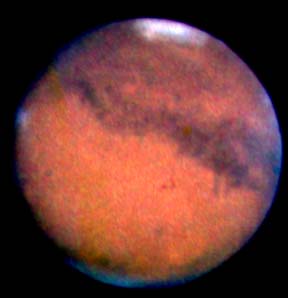
NATIONAL ASTRONOMICAL OBSERVATORY OF JAPAN
Mars will be at its closest point to Earth in more than 59,000 years tonight. This image of the planet was taken on Saturday by the Subaru Telescope at the summit of Mauna Kea.
Local telescopes turn
to brilliant Mars tonight
Leeward Community College is opening its observatory tonight to anyone interested in seeing Mars at its closest point to Earth.
Kakkala Mohanan, astronomy and geology instructor, said the college's two telescopes will be available from 7:30 p.m. until at least 10 p.m. "If people are interested and there, I will stay up until 12 or 1 a.m."
According to NASA's calculations, the red planet will be about 34.7 million miles from Hawaii at 12:47 a.m. tomorrow, the closest it has been for 59,617 years.
Mohanan said he opened Leeward's 12-inch telescope and 20-inch Ritchey-Chretien telescope to some students and area residents Monday night but it was difficult to see anything good because of rain and clouds.
Bishop Museum Planetarium Manager Mike Shanahan expects favorable weather for a "Mars Fair" there starting at 8 tonight and continuing until midnight. But he said the event, featuring a number of activities, will go on "come rain or shine."
The public will be able to view Mars from the planetarium's telescope and telescopes set up by the Hawaii Astronomical Society.
Chaminade University astronomy students will be able to observe Mars, as well as other planetary and stellar objects, from a new robotic observatory, the E.L. Wiegand Astronomical Observatory.
A private dedication ceremony was held last night for the facility, including two optical telescopes housed in a 12-foot-diameter observatory with a 10-foot high dome.
The telescopes sit on a high precision mount capable of pinpointing an object in the night sky and tracking spacecraft in the daytime.
Students can operate the telescopes by electronic controls from Chaminade's Wiegand Physics Laboratory, about 1,000 feet below the observatory.
Architect-astronomer Joseph Lancor donated his services to design the facility in a project spearheaded by Chaminade physics professor David Cooke.
"The idea is not necessarily to turn out astronomers," Lancor said. "But when kids look at the galaxies or the rings of Saturn, it fires up their imagination."
Jim Miller, chairman of the university's Natural Sciences and Mathematics Division, said when someone sees Mars through a telescope for the first time, "they do a double take when they see the background of lights not visible with the naked eye. It's pretty spectacular."
The Chaminade observatory isn't open to the public but people may see Mars without telescopes, weather permitting.
G. Jeffrey Taylor of the University of Hawaii Institute of Geophysics and Planetology, a member of a Mars Odyssey scientific team, said he enjoyed seeing the planet over Waikiki during a walk yesterday morning.
"It was beautiful, very bright, but not as red to me as when it is smaller."
Taylor is on a Gamma Ray Spectrometer team for Mars Odyssey, launched by NASA April 7 last year.
Mars' near-visit to Earth "is a great sky display," Taylor said.
"It is an important event, one of those events that just does not happen often. It would be nice if everyone put down guns and looked at Mars around the world."
